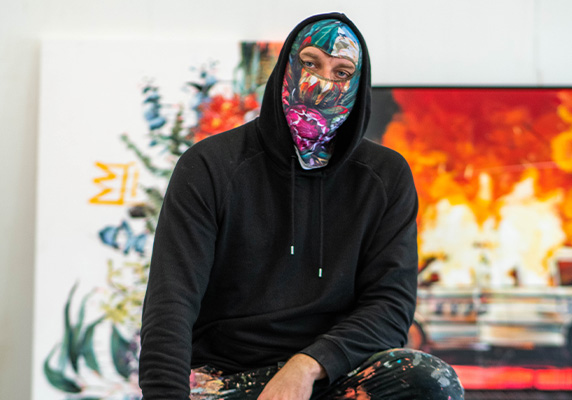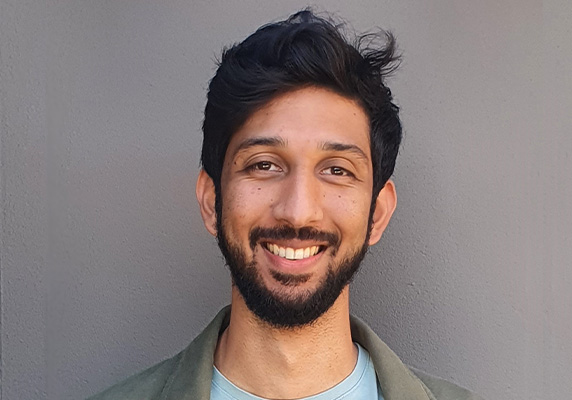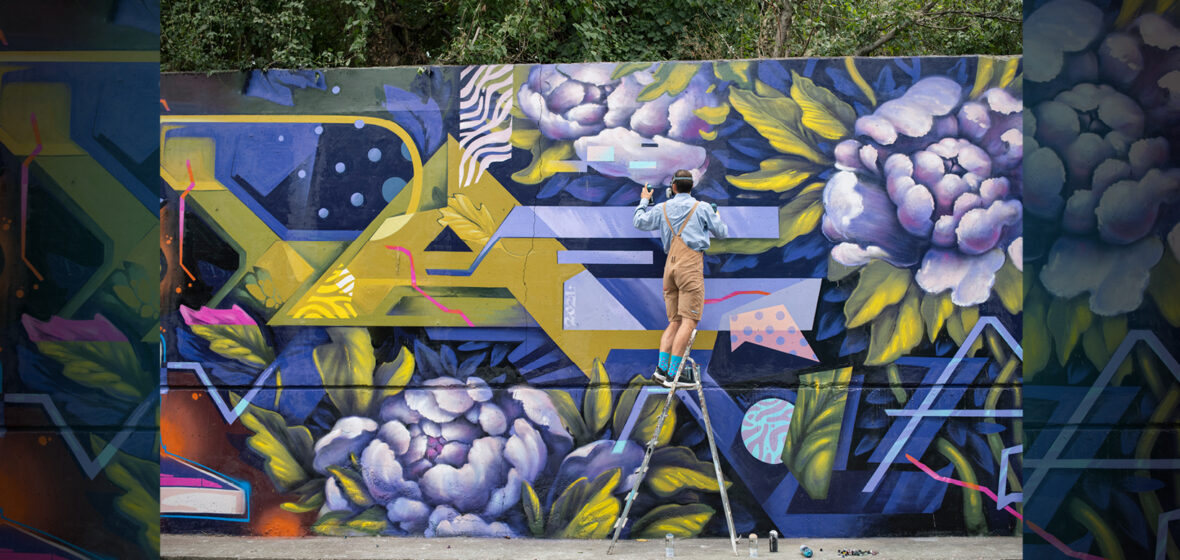The intellectual property rights of street artists are barely appreciated or understood – even in the street.
Casual observers might assume street art is uncommissioned at best and vandalism at worst, but the majority of large and lasting murals in NSW were painted on private property with the consent of the property owner.
However, earlier this month and unnoticed by the media, a prominent Sydney mural by an internationally known artist was wiped out with no consultation with its creator. ‘Ivory Tower’ by Scott Marsh showed a cast of climate-change minimalisers pontificating while koalas burned in the Black Summer bushfires of 2019-20.
Marsh, sometimes referred to as “Australia’s Banksy”, has a Bachelor of Fine Arts from the University of NSW and has been a finalist in both the Archibald Prize and the Moran Portrait Prize. He had painted ‘Ivory Tower’ on the side of a two-storey building with permission from the property owner, who recently accepted a more lucrative offer for his wall space in Chippendale.
“There’s a bunch of ad companies picking walls that have public artwork on them and turning them into poster ad-space or hand-painted ad-space,” says Marsh, talking exclusively to LSJ. “They just destroyed the mural. The ad company never contacted me, even though they know exactly who I am.”
“They painted the whole wall blank,” Marsh says, “and at the bottom of the wall they put these timber frames where they put posters inside.”

Solicitor Aditya Vasudevan of the Arts Law Centre of Australia says that street artists often come to Arts Law for advice when they are commissioned to work on development projects or for building owners. The artists are concerned about “what rights they are handing over to the business or the developer or the property owner who has commissioned them”, he says. They want to know, “Can the property owners take photos of the work? What are they allowed to do with those photos? Are they just for promoting the development? Or do they have other uses?
“The other issues that comes up down the track might be maintenance of the work – is it going to be looked after? – but also destruction of the work,” says Vasudevan. The property owner generally has the right to demolish or move the building, but the artist retains some rights within copyright law.
“For example,” says Vasudevan, the owner must “make reasonable enquiries with the artist to give them a chance to make a record of the work – to come and take photographs of it for their own portfolio, or whatever – and they have to consult with the artist in good faith about what’s going to happen to the work. But beyond that, they’re able to do with it what they want.”

“Street artists think about creative-art things: the building that they’re using, who might be walking past it,” says Dr Adrian Doyle, director of the Blender Studios in Melbourne. “Graffiti doesn’t give a s**t if you understand – you’re excluded from it anyway. It’s a subculture that only respects itself.”
Doyle, like Marsh, grew up tagging trains. He says he only scored 17 in his Victorian Certificate of Education out of a possible total of 50, but succeeded in getting into art school, and he was eventually awarded a PhD from Victoria University for his thesis examining the intersection between fine art and street art.
Different states have different laws governing where artists can paint and the penalties that could face uncommissioned artists for offences ranging from trespass to criminal damage. Different rules, and different levels of community support, apply in different parts of different cities.
“I live in Newtown in Sydney,” says Vasudevan, “and there’s murals everywhere around here. The whole inner west is filled with commissioned murals. In my little bubble, murals are authorised.”
Throughout Australia, it is illegal to mark property without the consent of the owner. In Victoria, an offence occurs if graffiti is publicly visible and “offensive”, even if it has been painted with the property owner’s consent. Only in NSW, Queensland and Western Australia can councils remove graffiti without the consent of the property owner in certain circumstances.
“And there have been famous examples of works being destroyed for different reasons,” says Vasudevan. “There was the Scott Marsh mural of the burning police car in Redfern, and the police requested of the private-property owner that it be taken down.”
‘Street artists think about creative-art things: the building that they’re using, who might be walking past it.’
In June 2020, when the Black Lives Matter protests re-erupted in the US, Marsh painted on the wall of a hardware store in Glover Lane, Redfern, a dramatic mural of a police car in flames. Across the burning bodywork of the vehicle was scrawled “BLM” and “TJ Hickey”, the latter in memory of an Indigenous youth killed while being followed by police in Redfern in 2004. Marsh had painted with permission from the store owner.
‘The mural had been up for about three days,” says Marsh.” It was tucked away so it wasn’t on full public view and that was on purpose, because of local people that knew TJ or who were associated with the fall out of that: I didn’t want them to have to relive it every day.
“So I painted it, I posted it social media,” says Marsh.
When street artists first post a new work, they often do not indicate its location.
“There’s a whole underground movement of street-art ‘spotters’,” says Doyle, “and they compete to be the first people to get street art on Instagram or whatever. A lot of them have put [the images] in books, printed them off and sold their photos.”
In this case, the street-art spotters were the NSW Police. Within 45 minutes, says Marsh, he took a phone call from the manager of the Lord Gladstone Hotel in Chippendale, telling him that detectives had come into the pub looking for the mural.
“The next morning I just had a bit of an instinct that I should check on the wall,” says Marsh. “I went past and the cops were there with a bunch of council people. They had blocked off the laneway, and they were painting over it.”
NSW police told the media that they were acting “after receiving several complaints from the community”. A year later, a recording of those complaints was leaked to an ABC journalist, and it turned out that the element of the community that had complained was NSW Police: an officer had called the City of Sydney customer service line to demand the removal of Marsh’s work.
Taken out of the setting of “graffiti”, Marsh’s work would have been seen as an acclaimed artist’s public comment on the most widely debated cultural and political movement of this century so far, and an immediate and accessible effort to place the slogan “Black Lives Matter” in a local historical context.
If the piece had been hung in a gallery, the police would never have expressed an opinion.
Although it seems unlikely that police might be legally permitted to act as arbiters of community standards in street art – anymore than they can veto the hangings in an exhibition – Marsh did not take legal advice.
“I didn’t have an avenue that wasn’t going to cost me money,” he says. “I’d gone down that path with some things in the past and it just seems to be a big headache and it doesn’t go anywhere.”
But advertising does not have to cover over street art to make use of its space.
Street art can lend an air of creative credibility on an otherwise undistinguished laneway, which then becomes a backdrop for “edgy” advertising photoshoots of sneakers or cars. “If you put something in public space then technically it’s part of that public space,” says Doyle. “But if they zoom in and just take your image, then you have a case [under copyright law]. If they do a long shot and get a couple of pieces, or get a bit of a feel, then that’s less of a problem.”
‘If you [paint] something in public space then technically it’s part of that public space. But if photographers zoom in and just take your image, then you have a case under copyright law.’
Respected street artist Tim Phibs was at the centre of an intellectual property stir in 2015 when a Bank of Melbourne advertising campaign “wholecar’d” trams and buses with images of Phibs’ work and the slogan “We stand proud and say ‘I made that’” – without permission from the artist who really had made it.
The bank paid Phibs a fee after the fact, but the commercial exploitation of street art on public transport was ironic in a city that had obliterated murals and graffiti from its railways in a ruthless clean-up before the 2006 Commonwealth Games.
That clean-up inspired a protest by Banksy, now the most popular contemporary artist in the world, who described the graffiti scene in Melbourne as a “key factor in its status as the continent’s hothouse of creativity and wilful individualism”.
In 2021, Banksy used Australian law to make street-art history by successfully registering two of his most famous images (‘Love is in the Air’ and ‘Girl with Balloon’) as trademarks in this country. The artist, who wrote “copyright is for losers” in his book Wall and Piece, had failed in a similar attempt to trademark the work in Europe.
As well as the law of the land, the street-art scene is subject to the law of the street. Although the bigger, more proficient murals often get tagged by “graffiti kids”, Doyle says that “the general rule is you can’t go over what you can’t do better than.”
“But” he adds, “often that’s a bit of a problem for young kids with big egos.”
Unauthorised street artists or graffiti kids, who risk arrest for a range of offences, most notably criminal damage, rarely approach Arts Law for help.
“We get a few,” says Vasudevan, “but graffiti artists, to some extent, may see their work as transient anyway. If they’re trespassing on private property to do the work, they’re not really super keen on coming forward as the artist either. They’re just, like, ‘It’ll be up for however long it’s up. People will take photos of it. But I don’t expect it to be up for ever because that’s the nature of what I’m doing.’
“That might be the reason we’re not seeing them – not because they’re not having issues about how their work is treated.”




